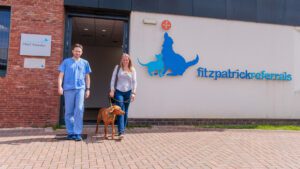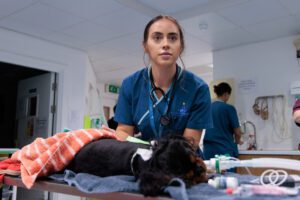Methods
Electronic clinical records of patients presented at our veterinary referral hospital between April 2009 and November 2018 were searched for cervical myelopathies associated with vertebral cervical malformations. We retrieved information regarding age, sex, breed, body weight, clinical signs, diagnostic imaging, level and type of cervical malformation, treatment modality, surgical technique, postoperative complications, medium and long-term follow-up and outcome (Table 1). Cases were numbered according to the radiological findings and presumed aetiopathogenesis. Follow-up was defined as a re-examination performed at our centre or via a telephonic conversation with the client. Medium-term follow up was defined as follow-up up to 180 days after the initial presentation at our centre. Long-term follow-up was defined as follow-up for 181 days or longer. All cervical malformations were diagnosed via high-field magnetic resonance (MR) scanning (1.5 Tesla; Siemens Symphony Tim system, Enlargen Germany), computed tomography (CT) examinations (160-slice Aquilion Prime Toshiba, Japan) and/or radiographic studies (Cuattro DR, United States). MR protocols included at least a sagittal and transverse T2-weighted (T2W) sequence and dorsal short-tau inversion recovery (STIR) sequence. Radiographs of the cervical spine included at least a neutral right lateral and a dorsoventral view. Post-operative imaging included CT scan and/or radiographs to confirm adequate implants positioning. All images were evaluated by ECVS, ECVN and ECVSMR diplomates. Patients diagnosed with atlantoaxial instability associated with abnormalities of the dens, caudal cervical spondylomyelopathy and craniocervical junction abnormalities associated with Chiari-like malformation were not included in this study.
Results
Electronic clinical records at our veterinary referral hospital between April 2009 and November 2018 were searched for patients presented with cervical myelopathy secondary to an underlying suspected vertebral malformation/instability. Nine dogs met the inclusion criteria. Two dogs were diagnosed with atlantoaxial pseudoarthrosis, two dogs with a syndrome similar to Klippel-Feil in humans, two dogs with congenital cervical fusion, two dogs with congenital C2-C3 canal stenosis and deficiencies of the dorsal arch of the atlas and laminae of the axis and one with axial rotatory displacement. Tetraparesis, proprioceptive deficits, cervical hyperesthesia and cervical scoliosis were the most common clinical signs. The axis was the most commonly affected vertebrae (8/9 patients). Patients diagnosed with Klippel-Feil-like Syndrome were the younger (average of 262.5 days) and patients diagnosed with fused vertebrae the oldest (average of 2896 days) in our studied population (average of 1580.8 days).
Conclusion
Cervical vertebral malformations are rare, or alternatively, being underdiagnosed in veterinary medicine. Patients diagnosed with Klippel-Feil-like Syndrome had a successful medium and long-term outcome with conservative management. Surgical treatment was often indicated for the other conditions presented in this study due to spinal instability and/or myelopathy. Stabilisations via ventral approaches were revealed to be safe. Multicentre and prospective studies are necessary in veterinary medicine to better characterise clinical outcomes in cervical vertebral malformations.
Summary
Disregarding atlantoaxial instability in toy breed dogs associated with dens malformation and cervical spondylomyelopathy; cervical vertebral malformations are rare and poorly characterised in veterinary medicine and consequently treatment strategies and clinical outcome are sparsely documented.



